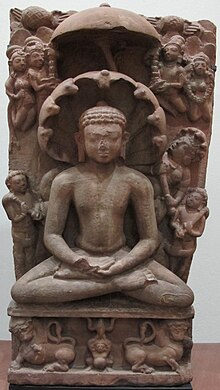Parshva
| Parshvanatha | |
|---|---|
| 23rd Jain Tirthankara | |

Image of Tīrthankara Parshvanatha (Victoria and Albert Museum, 6th-7th Century)
|
|
| Venerated in | Jainism |
| Symbol | Snake |
| Height | 9 cubits (13.5 feet) |
| Age | 100 years |
| Color | Blue |
| Spouse | Prabhavati |
| Parents |
|
| Preceded by | Neminatha |
| Succeeded by | Mahavira |
| Born | 872 BCE Varanasi |
| Moksha | 772 BCE Shikharji |
Parshvanatha (Pārśvanātha), also known as Parshva (Pārśva), was the twenty-third Tirthankara of Jainism. He is the earliest Jain leader (c. 872 – c. 772 BCE) for whom there is reasonable evidence of having been a historical figure.
Circumstantial evidence including a description of the teachings of Parshvanatha in the Sayings of the Seers, dictates that Parshvanatha can be viewed as a historical figure. Historians like H. Jacobi considers him as historical figure, because his Chaturyama Dharma (four vows) is mentioned in the Buddhist scriptures.
Parshvanatha was born on the tenth day of the dark half of the month of Paush to King Asvasena and Queen Vamadevi of Benaras (now Varanasi). He belonged to the Ikshvaku dynasty. He assumed and began to practice the twelve basic vows of the adult Jain householder when he reached the age of eight. He is said to have married Prabhavati, the daughter of Prasenajit (King of Kusasthala).
Parshvanatha lived as formal prince of Benaras (now Varanasi) and at the age of 30, he renounced the world to become a monk. He meditated for 84 days before attaining Kevala Jnana under a Dhaataki tree near Benaras. His first disciples were his mother and wife. After preaching for 70 years, he achieved moksha at the age of one hundred atop Shikharji, which is known today as the Parasnath Hills after him. Parshvanatha was called purisādāṇīya (beloved of men), a name which shows that he must have been a genial personality. He remains beloved among Jains.
...
Wikipedia
